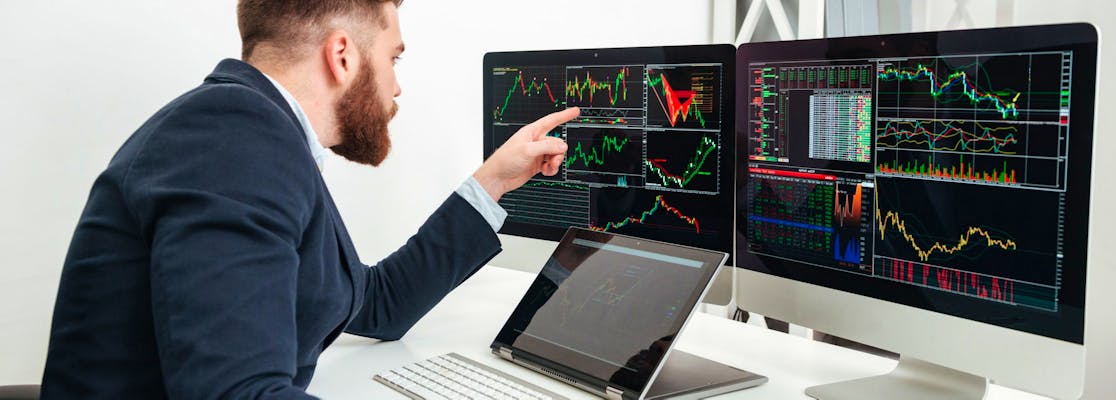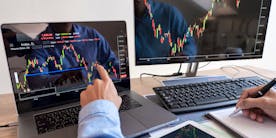End-of-Day Trading: Reasons You Should Try It in 2025
All products and services featured are independently selected by WikiJob. When you register or purchase through links on this page, we may earn a commission.
- A list of the Top Trading Brokers for January 2025:
- Description of the Best Trading Brokers for January 2025
- Why Do Traders Choose to Use End-of-Day Trading?
- What Times Constitute End-of-Day Trading Hours?
- What Are the Benefits of End-of-Day Trading?
- Reasons to Try End-of-Day Trading in 2025
empty
empty
empty
empty
empty
empty
empty
empty
- Frequently Asked Questions
- Final Thoughts
If you are a serious investor, then you will likely have come across day trading. This is when you focus all your investment activities on the stock markets during regular working hours when the markets are operating at full capacity.
But you may also have come across the term end-of-day trading.
This is where you conduct the majority of your investment transactions as the markets start to close.
There are many reasons why traders may choose to undertake an end-of-day trading strategy; this article will detail some of them.
A list of the Top Trading Brokers for January 2025:
Description of the Best Trading Brokers for January 2025
1. Plus500
Pros
- No buy/sell commissions and tight spreads
- Leverage of up to 1:30
- FREE unlimited Demo
- 2,800+ trading instruments
- Real-time quotes and advanced analytical tools
- Fast and reliable order execution
Cons
- No API integrations
- No social copy trading
Another user-friendly entry on our list of the best forex and CFD brokers in the UK is Plus500, providing an easy-to-use and accessible service.
You’ll find over 60 CFD currency pairs with competitive spreads, no commission and available leverage of up to 1:30.
Although MetaTrader and cTrader are not available, Plus500’s own platform is very user-friendly. It comes with a range of intuitive risk management features and is available on web and mobile.
Plus500 requires a minimum deposit of £100 if using a credit or debit card, and £500 if using bank transfer.
Plus500 UK Ltd authorized & regulated by the FCA (#509909).
2. eToro
Pros
- Regulated by FCA, ASIC
- No withdrawal fee for US clients
- 0% commission on stocks
- Social and copy trading
Cons
- Not available in every US State
- More expensive than most of its competitors
- No MetaTrader platforms
Below content does not apply to US users
Founded in 2007, eToro is considered a very low-risk broker as it is highly regulated by the Financial Conduct Authority (FCA) in the UK and many other regulatory bodies elsewhere.
Opening an account is free and you can access a $100,000 demo account to test the system.
It offers 47 currency pairs for trading. Spreads for forex trading have recently been significantly reduced and range from a very competitive 1 to 3 pips for major currency pairs.
Typical spreads for EURUSD and USDJPY trades, for example, are just 1 pip.
You can see the full list of spreads on the eToro website.
You’ll need to deposit a minimum of $200 for Copy Trading, eToro's standout feature which allows you to follow other traders and copy their trades.
This forex broker is great for beginners due to its user-friendly interface and app and 24-hour customer support. It allows you to trade currencies, stocks and cryptocurrencies in one portfolio and the Copy Trading system is a great way to learn.
The company also offers trading courses and features a Learning Lab which houses a variety of tools to support clients with their trading experience.
To find out more, read our eToro review.
61% of retail investor accounts lose money when trading CFDs with eToro. You should consider whether you understand how CFDs work, and whether you can afford to take the high risk of losing your money.
3. IG
Pros
- Highly regulated
- MetaTrader 4 (MT4)
- Over 10,000 instruments
- Available in the UK and US
- 24/7 customer support
Cons
- High fees
- No deposit compensation scheme for US accounts
- No copy trading
- Inactivity fees
IG is a great share trading platform for beginners thanks to its user-friendly interface and extensive educational resources.
Pros of IG include a wide range of trading instruments and markets, as well as the ability to access multiple account types and trading platforms. The platform also offers a demo account for beginners to practise trading strategies before investing real money.
However, IG isn’t the cheapest share trading platform, with relatively high trading fees and a minimum deposit requirement of £250 when paying by credit/debit card or PayPal.
In terms of additional fees, IG charges a commission fee for share trading, starting from £8 per trade. There’s also a custody fee of 0.25% per year for holdings of £250 or more.
Overall, IG is a solid choice for beginners looking for a user-friendly platform with extensive educational resources, but investors should be aware of its fees and minimum deposit requirements.
4. Saxo
Pros
- Heavily regulated
- Good product portfolio
- Low forex fees
- No withdrawal or inactivity fees
Cons
- Does not accept US clients
- High fees for options, futures and bonds
Saxo is well-suited for end-of-day trading, providing tools and features that can cater effectively to traders who operate primarily at the close of trading sessions.
Saxo's platforms, SaxoTraderGO and SaxoTraderPRO, offer advanced charting tools that are essential for end-of-day trading. These tools allow traders to analyze price movements and identify trends based on the day's trading data. Features like custom indicators, comprehensive chart types, and historical data access give traders a robust framework for making informed decisions.
Saxo provides extensive market insights and analysis, which are crucial for end-of-day traders looking to make decisions based on the day’s market activities and overnight news. This includes expert commentary, market news, and forecasts that can impact the next trading day.
For markets that support it, Saxo offers access to pre- and post-market trading sessions, which are often important for end-of-day trading strategies. This feature allows traders to react to news and events that occur outside of standard trading hours.
End-of-day trading often involves precise timing to execute trades at or near the closing bell. Saxo’s platforms allow traders to set up automated trading strategies and alerts that can help manage trades at specific times, reducing the need to manually monitor positions continuously.
Saxo provides various risk management tools, such as stop-loss orders and take-profit levels, which are particularly useful for end-of-day traders to secure gains or limit losses as the market closes.
Trading with a regulated broker like Saxo ensures that all trading activities are conducted under strict regulatory standards, providing a secure environment for managing trades, especially when large price shifts can occur at the day's end.
5. Switch Markets
Pros
- Regulated by ASIC
- Low minimum deposits
- No deposit fee
- No inactivity fee
- Free VPS
- Social trading
- Tight spreads
- Useful trading tools and research
Cons
- No US clients
- Not FCA regulated
Switch Markets, as a trading platform, offers various features and services that can be particularly relevant for end-of-day trading strategies.
Switch Markets provides access to a range of markets including Forex, commodities, indices, and possibly other instruments. This variety is beneficial for end-of-day traders who may be looking to trade across different asset classes.
For end-of-day trading, traders often rely on detailed charting tools, technical analysis capabilities, and historical data, which are typically available on platforms like Switch Markets. The ability to analyze price trends and market movements at the end of the trading day is crucial for this strategy.
Reliable customer support is important, especially if the trader needs assistance at the end of the trading day or has queries regarding their trades.
Given that end-of-day trading decisions might be made while away from a traditional trading setup, mobile trading capabilities can be a significant advantage. Switch Markets likely offers a mobile platform, allowing traders to execute trades and monitor the markets on the go.
For those new to end-of-day trading, educational materials provided by the broker can be invaluable for learning effective strategies and understanding market dynamics.
6. Coinrule
Pros
- Works with a range of cryptocurrency exchange platforms
- Free account option available
- Various subscription tiers available to suit different needs
- User-friendly interface
Cons
- Monthly subscriptions can be expensive
- No mobile app
Fee: Free with a starter account or from $29.99 per month
With its simple, intuitive design, Coinrule is a good choice for those who are new to trading as well as more advanced traders.
Users don’t need to know any code to set their trading rules.
Coinrule is web-based and works across several cryptocurrencies as well as supporting some of the most widely-used exchanges, such as BitMex.
Why Do Traders Choose to Use End-of-Day Trading?
Trading is a very personal business. Some investors want to keep a close eye on their investments and, as such, they are fixed to the stock market news throughout the day.
Others prefer to take a wait-and-see approach, often making the most of hands-off investment strategies.
End-of-day trading is often used by investors who may be part-time traders. They may not have the time (or interest) to sit and watch the markets for hours on end.
Therefore, they dedicate a specific time each day to catch up on the news and make their transactions.
For those who are working a full-time job and see trading as a side hustle, it is an effective way of guaranteeing a regular income, whilst still participating in the stock market.
What Times Constitute End-of-Day Trading Hours?
If you are looking to benefit from end-of-day trading, you must be aware of the opening hours of your preferred market.
Some markets, such as stocks or futures, typically operate during traditional business hours (such as 9 a.m. to 6 p.m.).
Other markets, such as forex, can be active 24 hours a day.
Each market will have distinct trading hours, so you need to consider this as part of your due diligence before choosing to embark on an end-of-day trading strategy.
Do not forget that if you are choosing to invest in an overseas market, you need to pay close attention to time zones.
The opening hours for markets in Europe can differ because, broadly speaking, there are four main time zones:
- Greenwich Mean Time
- Western European Time
- Central European Time
- Eastern European Time
You also need to consider daylight saving time.
What Are the Benefits of End-of-Day Trading?
There are no perfect plans when it comes to trading. Every single investment comes with a risk; you can never guarantee whether you will have a win or a loss.
But prior research and understanding of your market choices and implementing an effective stop-loss system could help to mitigate any potential losses.
With an end-of-day trading strategy, you can benefit from both context and flexibility.
During the day, your market will be extremely active, with traders buying and selling. As a result, changes in the marketplace are common and you may find yourself being pressured into making unwise decisions.
Simple announcements (such as a new base rate) can have an immediate effect on the market, yet they can stabilize within a few hours.
Therefore, an end-of-day trading plan means that you can take time to understand the context and the reasons for any movements.
This means you are making more of an informed decision, rather than reacting to the news or making decisions based on emotions.
You also have the flexibility to create an informed trading strategy based on your lifestyle.
Many end-of-day traders choose to have full-time jobs alongside their trading activities. This gives them a reliable income, so they are not completely dependent upon the performance of their trades.
Whether you choose to make your decisions using rationale and logic or you implement an automated trading system, you can use end-of-day trading to develop an effective and consistent system that does not need heavy management.
Reasons to Try End-of-Day Trading in 2025
Here are some reasons to implement an end-of-day trading strategy:
1. Able to Trade Alongside Your Day Job
As mentioned earlier, choosing to use end-of-day trading times to make your trades means that you can schedule a full-time trading strategy on top of your work and other interests.
You do not need to spend all day long monitoring the markets when they are at their most volatile. Instead, you can wait until it is almost time for the markets to close and make informed decisions based on the trade performance throughout the day.
This will give you more insight into its behavior and help you to make more effective decisions.
2. You Can Spend Less Time Trading
With an end-of-day trading strategy, you only need to look at the charts once a day.
If you choose to use a day trading strategy, your trade could rise or fall after you have placed your trade, so you would need continuous monitoring throughout the day to accurately judge your investments.
With end-of-day trading, because the market will soon close, once you have made your trade, you can switch off and forget about it.
This means that, ultimately, you will make more money in real terms because you are not having to work as hard.
If you use a time/money ratio, your hourly rate for your investments will be considerably higher if you only focus on trading for one hour per day, compared to traders who made the same investments but trade for four to five hours per day.

3. Spend Less Time Reading Charts and Over-Analyzing
Although good investors take their time to research and fully understand their markets, there is a thought that too much knowledge can be detrimental to your investment strategies.
If you spend your whole day reading charts and analyzing market behaviors, you can start to become overwhelmed with knowledge.
Rather than making informed decisions that are also driven by your gut instinct, you can become overly analytical which can hinder your success.
You may start to try to spot patterns and trends that may not be there. And with such a laser focus and tunnel vision, you may start to miss other signs that could suggest success (or failure).
If you become overly analytical, you will start to want to control things that cannot be controlled; this is where mistakes are made, and anxiety rises.
With trading, any decision you make is based on a 50:50 option:
Your investment will either rise or it will fall.
Spending all your time reading charts will not change this ratio. Therefore, be informed about what you are doing and why, but do not become obsessive – ultimately you will have the same success rate as those who make a trade and then forget about it.
4. You Can Benefit From Cheaper Trading Costs
It may surprise you to know that end-of-day trading can be cheaper than day trading.
This is because the fees work out to be less.
Your trading platform may charge high fees for real-time data and tracking, and the need for this will be considerably less with end-of-day trading.
This means that you can save on broker fees, as well as take advantage of free software tools to help enhance your decision-making.
5. Quieter Trading Can Be Easier to Decipher
During the day, the stock markets are notoriously busy. Trades are taking place all over the world, and changes in movement can be impacted by the sheer volume of traffic.
Additionally, breaking news from around the world can immediately impact the market, whether it is the announcement of a CEO retiring or a change in a currency’s base rate.
All of this can create a chaotic atmosphere making it difficult to know what decisions to make.
In contrast, at the end of the day, it is much easier to see what to do because the market has slowed down.
With less traffic and more time to see how things have changed, a quieter trading time can ensure you make your decision rationally and calmly.
You are not working from an adrenaline-fueled starting point. Instead, you can see how the day’s performance will make a difference to your investments.
6. Promotes Emotional Discipline
If you are too invested in your trade, you will start to make emotional decisions.
While it can be important to go with your gut and rely on your instinct, acting emotionally can lead to poor decision-making. And this can lead to sustained losses.
With an end-of-day trading strategy, you only have an hour to think about your investments. After you make your trade, you must switch off.
Second-guessing yourself is useless as you cannot make any changes and further news is irrelevant to your trade until the next day.
You become more disciplined and can start to be more strategic in your trading activities.
7. It Can Help Develop a ‘Set and Forget’ Mindset
Trading can be extremely stressful – and if you are trading during the day, you may find it hard to switch off the charts and reports once you have made your trade.
With end-of-day trading, it is easier to switch off completely because the markets will be closed, and you will know that there will be no movement for several hours.
It means that you can, and must, make a decision and stick to it.
Some people choose to implement automated strategies to help them with their end-of-day trading. By setting pre-defined parameters and a comprehensive stop-loss strategy, you can make plans, knowing that if changes do occur, your investment will be protected as much as possible.
8. End-of-Day Trading Makes It Easier to Follow Multiple Markets
Another final advantage of end-of-day trading is that it is much easier for investors who are trading across multiple markets.
With day trading, it can be difficult to keep track of all the changes in real-time, especially if you are working in the same time zone.
However, with end-of-day trading, you could focus on one key market (perhaps the Frankfurt Stock Exchange) and then, when that has ceased trading, move into a different area (such as the London Stock Exchange), which finishes an hour later.
These staggered closing times mean that you can focus your attention on one at a time.
You can use the different closing times to use software to automatically scan the market for any changes. You can then be far more selective about your trading choices and know that you are giving each investment the time and attention that it deserves.
End-of-day trading is a type of trading strategy in which traders make trades at or near the close of the trading day.
This strategy involves analyzing price movements and market trends throughout the day and making trading decisions based on that analysis.
End-of-day trading can be profitable if done correctly. Like any other trading strategy, success depends on a variety of factors such as market conditions, individual trading skills and risk management techniques.
End-of-day trading differs from other trading strategies in that it focuses on analyzing market trends and price movements over an entire trading day, rather than on short-term fluctuations or intra-day trading.
The benefits of end-of-day trading include reduced stress, lower risk of losses due to unexpected market events and the ability to analyze and make trading decisions based on broader market trends.
The risks of end-of-day trading include missing out on short-term opportunities and the potential for significant losses if unexpected market events occur after the trading day has closed.
To start end-of-day trading, you should first develop a solid understanding of market analysis and trading strategies.
You should also choose a reliable trading platform and develop a clear risk management plan.
The best platform for end-of-day trading will depend on individual trading preferences and needs.
Some popular options include MetaTrader, TradingView and Thinkorswim.
Some factors to consider in end-of-day trading include market conditions, trading volume and trends in key economic indicators.
The ideal time-frame for end-of-day trading will depend on individual trading strategies and preferences.
Many traders focus on daily or weekly charts to identify longer-term trends.
You can measure the success of your end-of-day trading strategy by tracking your trading results and analyzing key metrics such as win rate, profit/loss ratio and risk/reward ratio.
To improve your end-of-day trading performance, you should continue to refine your trading strategy, regularly analyze market trends and implement effective risk management techniques.
End-of-day trading can be a good option for beginner traders because it allows them to take a longer-term view of market trends and reduce the stress associated with short-term trading.
However, like any trading strategy, it requires careful analysis and risk management.
Final Thoughts
When choosing a trading strategy, some people may prefer day trading because it works better for their lifestyle. Others may want to do as little work as possible for the maximum gains.
End-of-day trading can be a highly valuable tool because you have time to look at the market objectively, clear of any emotional decisions. You can also make greater use of automated software because the market will not change once you’ve made your trade.
Additionally, as you get better at decision-making, you can limit the amount of time you spend focusing on your trades. This gives you a much better return on your investment if you consider the hour/money ratio.
It also depends hugely on what you are trading.
If you are trading futures or stocks, then there are clear advantages to using an end-of-day trading strategy. However, if you are trading forex, it operates 24/7 so you do not get the same benefits.
You should remember that just because a strategy works well for one market, it does not mean it will work as effectively for others.
Ultimately, there are no guarantees involved in trading.
You may think that you are at an advantage because you are considering all that day’s relevant data, but no trading strategy is ever foolproof.
All you can do is find an action plan that suits you and your lifestyle, with systems in place to help minimize your losses.
WikiJob does not provide tax, investment, or financial services and advice. The information is being presented without consideration of the investment objectives, risk tolerance, or financial circumstances of any specific investor and might not be suitable for all investors. Past performance is not indicative of future results. Investing involves risk including the possible loss of principal.







